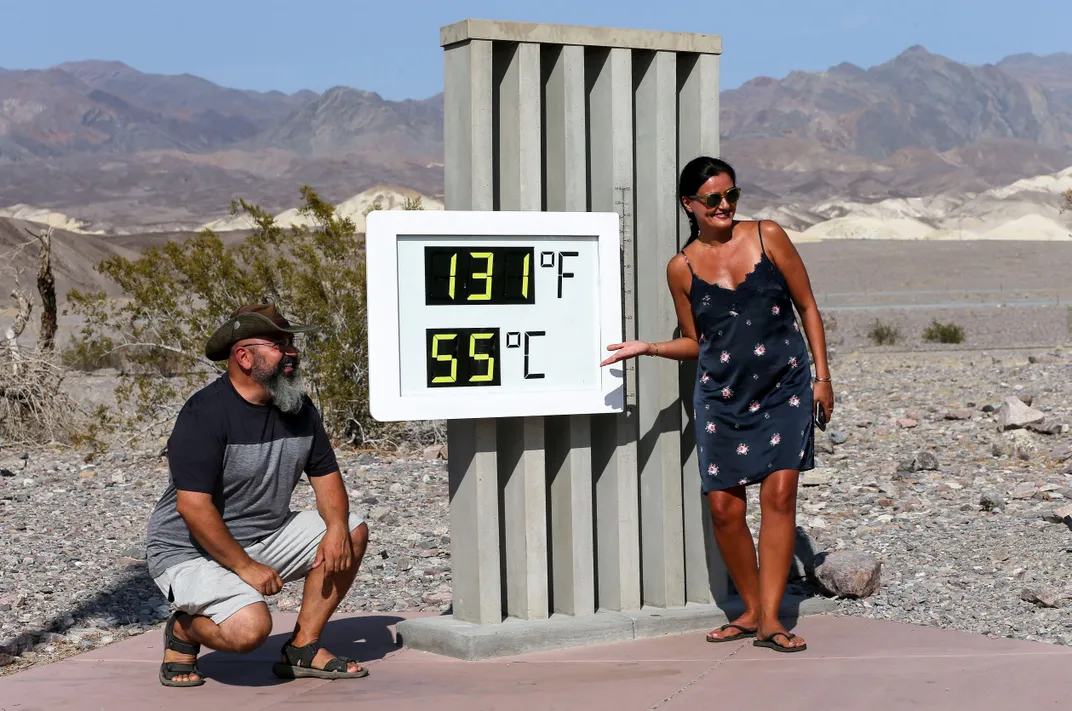Death Valley Hits a Blistering 130 Degrees, Potentially Setting New Record
If confirmed, this scorcher would be the hottest temperature recorded on Earth since at least 1931
/https://tf-cmsv2-smithsonianmag-media.s3.amazonaws.com/filer/25/23/25236b83-4706-45af-a281-4458196cbdf5/gettyimages-1267013641.jpg)
Death Valley, the lowest and driest point in the United States, may have set another world record on Sunday. Around 3:41 p.m. Pacific Time, the thermometer in Furnace Creek registered a blistering 130 degrees Fahrenheit, possibly setting a record for the highest temperature ever recorded on Earth since at least 1931, reports Jason Samenow for the Washington Post.
The World Meteorological Organization (WMO) announced Wednesday that it will look into and verify the recording. “All the indications so far are that this is a legitimate observation,” the WMO noted in a statement.
Only two recorded temperatures in history have been higher than this one. For one, Death Valley holds the historical record for the hottest temperature ever recorded on Earth, at 134 degrees, on July 10, 1913. However, that record was called into question by meteorologist Christopher Burt in a 2016 study. A 131-degree temperature was recorded in Tunisia in 1931, but that recording is also disputed, per the Post.
If this most recent record is confirmed, it would beat out three 129-degree readings made in Death Valley, Kuwait and Pakistan in the last decade, as Seth Borenstein reports for the Associated Press.

This milestone reading is the latest development in a blistering heat wave that’s been rolling over the western United States, forcing major energy blackouts and bringing intense thunderstorms and lightning to the area. As Scottie Andrew, CNN meteorologist, reports, more than 60 million people in the western US are under a heat advisory, watch or warning this week.
As Samenow and Matthew Cappucci write in a separate Washington Post report, the extreme heat has also intensified an already devastating fire season and led to the development of several “fire tornados” in the area.
What does 130-degree heat feel like? It’s a bit like “walking into an oven,” Death Valley ranger Brandi Stewart tells SFGate’s Amy Graff. “People say, ‘But it's a dry heat,’ and it is an extremely dry heat—I can immediately feel it on my face,” continues Stewart. “And when it’s windy, it then feels like someone is blowing a hair dryer at you.”
Patrick Taylor, the head of interpretation at the Death Valley National Park, tells SFGate that when someone steps outdoors in this kind of heat, they’ll immediately start sweating, which evaporates and leaves a “salty crust” on the skin. Tourists are encouraged to drink at least a gallon of water each day and limit their time outside.
As the Post reports, scientists have found that the intensity of heat waves has increased due to climate change. “We are having more extremes than we had in the past,” Randy Cerveny, an Arizona State University professor who coordinates the World Meteorological Organization’s extreme temperature team, tells the Associated Press.
As temperatures rise, the world is “creeping up on [the 134-degree record] year after year. That is something that cannot be denied,” continues Cerveny. “These extremes tell us a lot about what will happen in the future.”
/https://tf-cmsv2-smithsonianmag-media.s3.amazonaws.com/accounts/headshot/nora.png)
/https://tf-cmsv2-smithsonianmag-media.s3.amazonaws.com/accounts/headshot/nora.png)